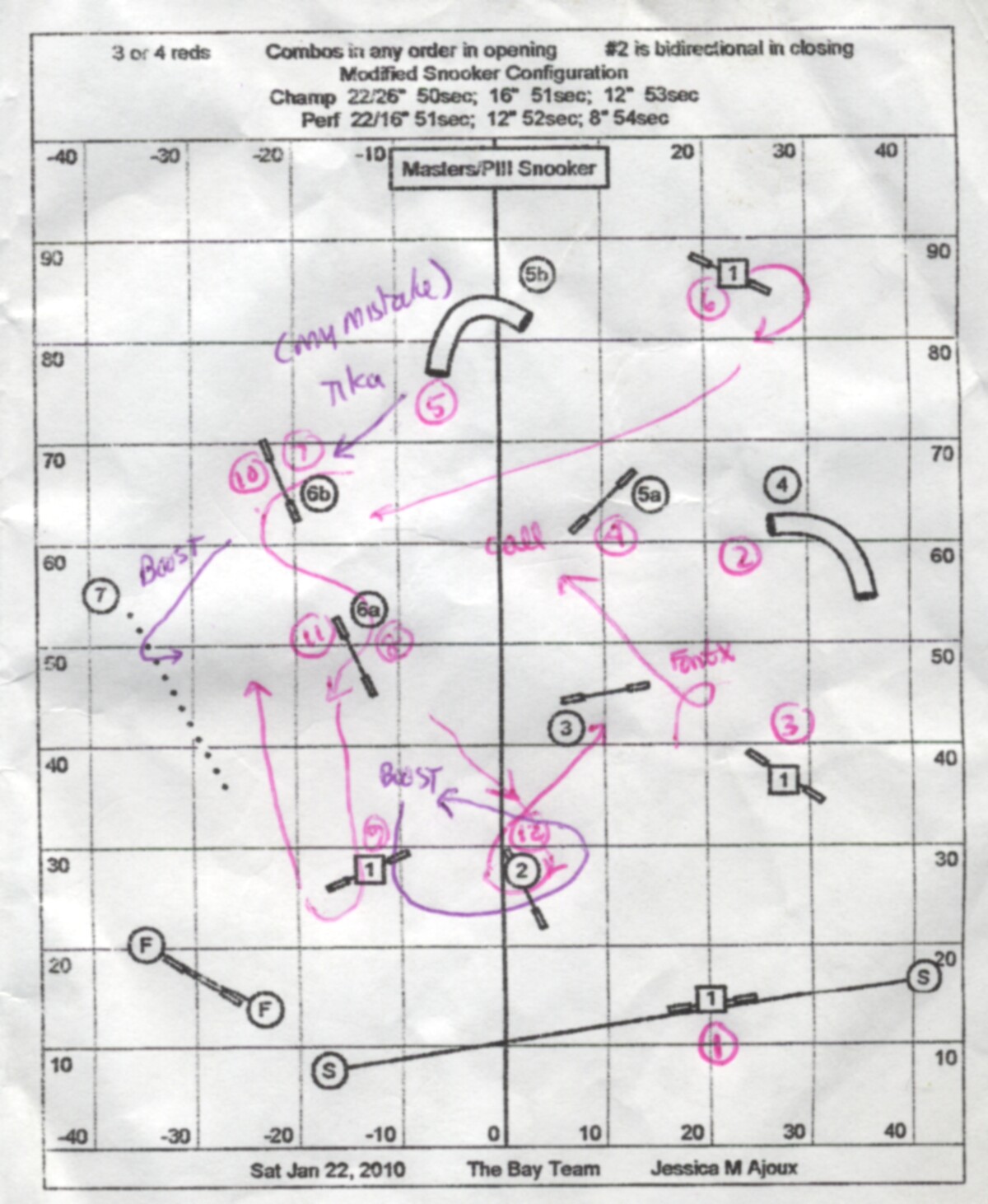SUMMARY: If I knew then what I know now.
Note: Dog agility bloggers are teaming up once every few months to all post on a common theme on the same day. Today is our first combined Dog Agility Blogger Event Day (well–second or third, we actually had an Agility Blogger Action Day some time back), and the topic is “If I knew then what I know now.” See the list of other posters here; will be updated throughout the day.
So many people joke in the agility world about “going over to the dark side” after their first agility dog–or two, or three–do OK in agility (or not) but can’t beat those beasts who seem to have been designed for the sport: The beautiful, driven, smart, workaholic Border Collies.
I hadn’t intended to give in. I’ve always liked BCs and blue merles. I liked Boost’s mom, Tala, long before there was even a vague hint of future puppies. And I just happened to be starting to think about a new dog when Boost’s litter came along.
I agonized about the price. I paid $1000 for my rocket-driven girlie, and it was difficult for me to come up with that at the time and very difficult for me to justify when I was pretty sure that, sooner or later, I’d be able to find a rescue, shelter, or rehomed dog for a fraction of the price who’d do just fine. But, yes, I fell in love with her as soon as I broke down and went to spend some time with the puppies.
She has turned out to be a sweet and eager-to-please dog. She has all the drive, speed, and willingness to work that one could ever want from a dog. She was a natural on sheep when introduced to them; she has fabulous herding instinct and it’s clear, when she moves into a ring with critters, that herding was what she was born to do.
She also loves doing agility; it is her job, and she loves her job; it is her exercise, and she desperately needs the outlet for her physical and mental energy; and it is her time spent with me, which she also loves beyond pretty much everything except maybe herding (usually other dogs, since we don’t see many flocks o’ grazing animals in Silicon Valley).
Each of my three previous agility dogs got better and better, as I learned more about handling and about training. She was going to be my best yet.
But she isn’t.
As those who sometimes read my blog may know, we have a terrible time with refusals, runouts, and bars going down. Oh, and the recurring weave pole failures.
See, none of my previous three dogs ever had runout or refusal issues. (Definitions: A runout is when the dog runs past the plane of the next obstacle; a refusal is when the dog approaches the obstacle but then doesn’t take it, usually by turning back. They actually represent a continuum of behavior–hard to draw the line between where refusals end and runouts begin–and they are scored the same.)
Of my previous three dogs, only Tika had bar-knocking issues, but at its worst, it was never anything like Boost’s.
And weave poles–well, Remington was never fast in them, Jake was sometimes not perfect, but Tika has always had awesome weave poles (enters correctly and independently, fairly fast, and stays in until the end), so I figured, yeah!, I’ve figured out how to train them! But, apparently, not.
Yes, I’m getting to my point.
I’ll admit that I’m 7 years older than when I got Boost; I hadn’t yet had knee surgery when I got her; and I had competed in only 135 trials when Boost came home with me; I used to train in the yard almost every day and found it exciting and entertaining. Now, I have a crappy knee, crappy hip, additional years of aging that have been starting to show more and more, and another 120 trials under my belt, during most of which I have felt like a failure with Boost. And I have lost my enthusiasm for agility and for training.
How much of it is the been-there-done-that thing? And how much is the sense that I have blown my chance with my dog and don’t have a great future to look forward to with her in agility?
Here’s the thing: When I read back through my posts about Boost’s training and agility experiences in the first couple years of her life, it is all there: The bars, the refusals because my timing is bad or whatever, the inability to do serpentines that cause runouts, the weaves that are on-again, off-again, and even the stupid contact issues that are now plaguing me again: Coming off the side of the teeter instead of streaking to the end. It is all there, all of it.
And I worked on some of it, sometimes. I think that I fell into the trap of thinking that, with experience, things would get better. I mean, things got better with all my previous dogs as we each gained more experience.
In fact, I’m still falling into that trap, as in, “Maybe if I do a ton of CPE trials, where the courses are usually simpler and often smaller (in total distance) than USDAA courses, we’ll learn to run more smoothly together.” I can safely say, after 4 CPE trials in quick succession, that that is not happening.
The thing that I keep coming back to in understanding why we have problems with things that the other dogs didn’t is that she is, first and foremost by instinct and breeding, a herding dog. She stops and changes direction on a dime. She pays utter close attention to things that are moving (sheep, me), not things that are stationary (jumps). She wants to get to where the action is ASAP.
So, if I had known when she was a puppy that, at age seven, she’d have only 3 Jumpers Qs in USDAA after 90 tries, only one Super-Q after 80 tries, almost never any placement ribbons despite her speed even when we do manage to Q (mostly because of time-wasting bobbles on course), here’s what I would have done differently:
- Recognized sooner that Boost is an entirely different kind of machine than my previous three agility dogs and approached her training and my own training in that light.
- Gotten some coaching on a regular basis on my own fitness and running ability.
- Made sure that we attended a lot of foundation training classes very early on.
- Made the effort to rent the big agility field regularly to just let her run in huge loops, full speed, over agility obstacles and not work exclusively in my small yard and the tightly controlled confines of classes.
- But most importantly, as soon as I realized that I had an issue–something that happened more than two or three times or that we never successfully managed–I’d have gotten help and followed the exercises and assignments closely and determinedly.
I don’t know whether it would have helped–I like to think that I have a clue about weave poles, and for the first three years or so I worked aggressively on weave training, and that was never completely fixed, either. But I think we’d have done Oh, so much better.
Now, it’s hard to get around the blasé feelings about training, the sense that it doesn’t matter and I’ll never fix the problems–Boost *is*, after all, already 7 and past her physical prime, just a fact.
It’s hard. I did NOT know then what I know now, and it is a challenge for me to let it go, let it go, let it go, and find a new enthusiasm. It is both an advantage and disadvantage that I know now EVERYTHING that I know now. Because I think that, if I want to be successful, I actually have to forget a lot of what I know now, shed the emotional baggage and history of failure, so to speak, to be able to get a new lease on Boost’s agility life and training.
I’m trying to find within myself the energy and enthusiasm that I might have felt if, say, I’d have not gotten another dog, and then had suddenly found myself with Boost in my family, rehomed at age 7 with all of her training and foibles already in place. In other words, give myself a fresh perspective and permission to start over.
(The longer-term If I Knew Then question will be–would I have forsaken agility and taken up herding? But that’s something for the distant future.)
P.S. In the end, I am glad that I wrote this post, although I agonized for days about what to say and how to say it, and almost didn’t write it because of the pain I feel on this subject and not sure whether I could turn it into something positive–because the insights in the last two paragraphs didn’t come until I had written everything else. Let’s see whether I can do something with that interesting new perspective.
















